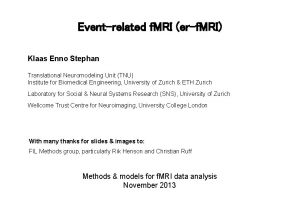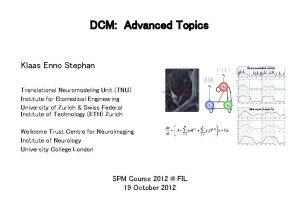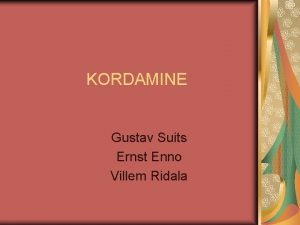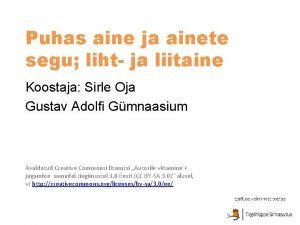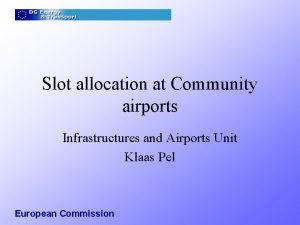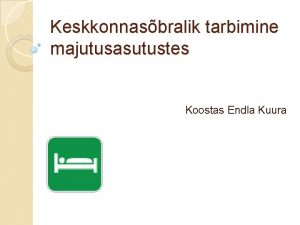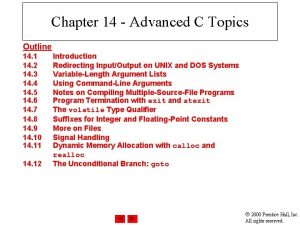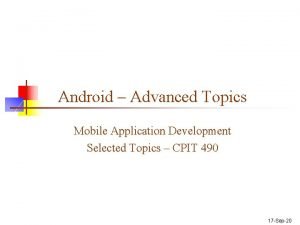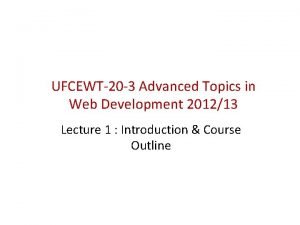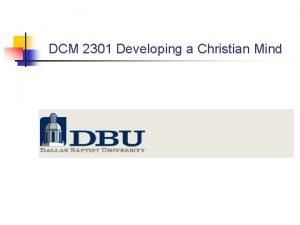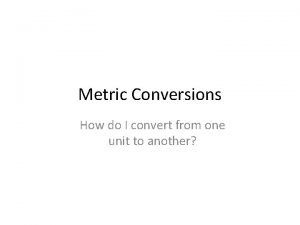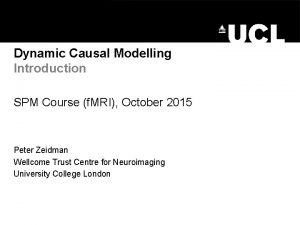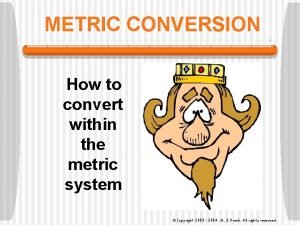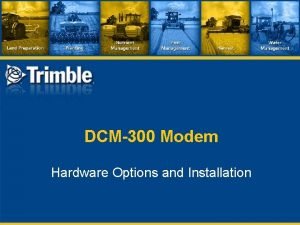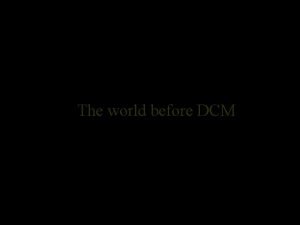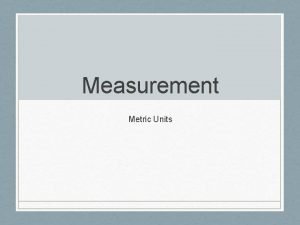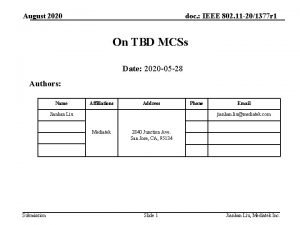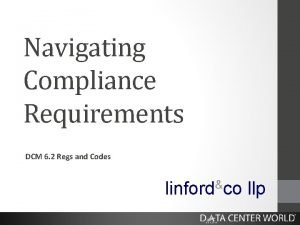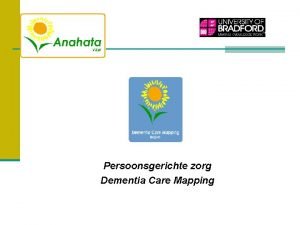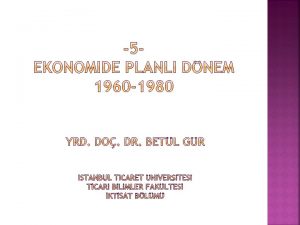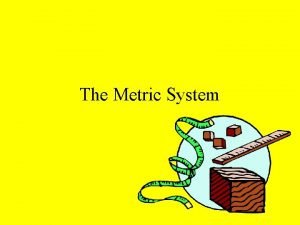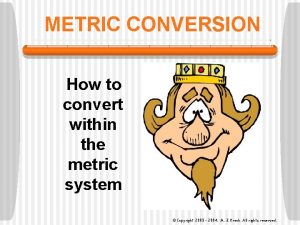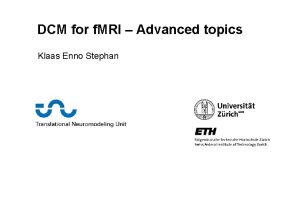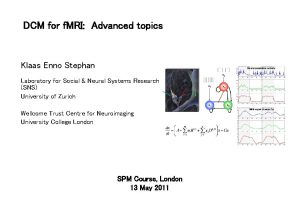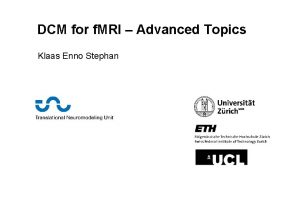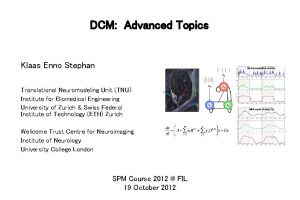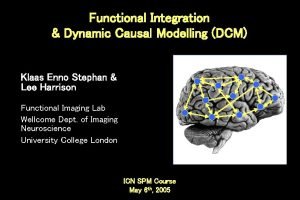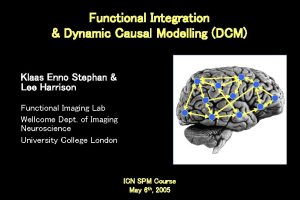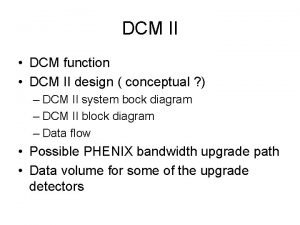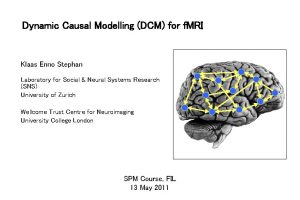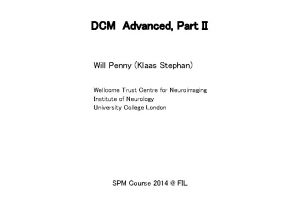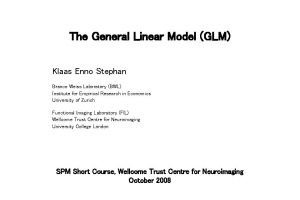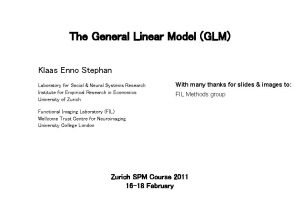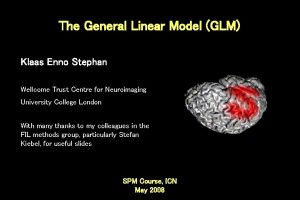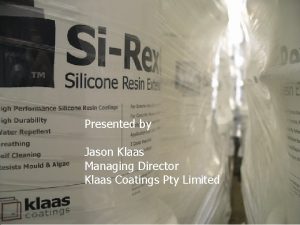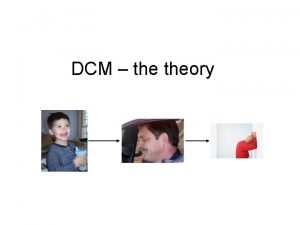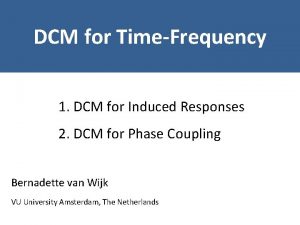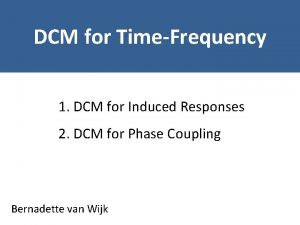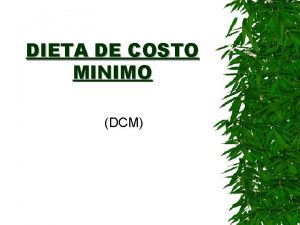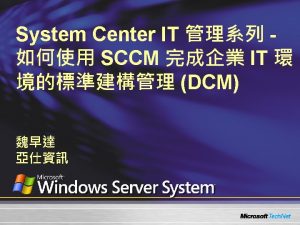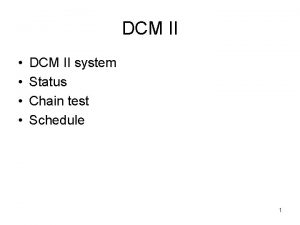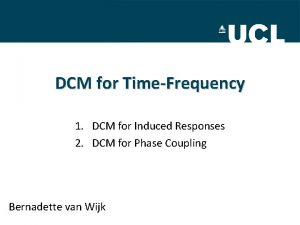DCM for f MRI Advanced Topics Klaas Enno



















































- Slides: 51

DCM for f. MRI – Advanced Topics Klaas Enno Stephan

Overview • DCM: recap of some basic concepts • Evolution of DCM for f. MRI • Bayesian model selection (BMS) • Translational Neuromodeling With many thanks for slides to Peter Zeidman

Dynamic causal modeling (DCM) dw. MRI f. MRI EEG, MEG rs prio ural t struc Forward model: Predicting measured activity Friston et al. 2003, Neuro. Image struc tura l prio rs Model inversion: Estimating neuronal mechanisms

Modulatory input Driving input u 2(t) t Neuronal state equation u 1(t) t endogenous connectivity modulation of connectivity direct inputs Local hemodynamic state equations Hemodynamic model Balloon model BOLD signal change equation BOLD signal y(t) vasodilatory signal and flow induction (r. CBF) Stephan et al. 2015, Neuron

Bayesian system identification Design experimental inputs Neural dynamics Define likelihood model Observer function Specify priors Inference on model structure Invert model Inference on parameters Make inferences

Solutions to previous weaknesses of DCM • vulnerability to local extrema global optimisation : – MCMC: • Sengupta et al 2016, Neuro. Image • Aponte et al. 2016, J Neurosci Methods – Gaussian processes: Lomakina et al. 2015, Neuro. Image • choice of priors hierarchical models (empirical Bayes) – Friston et al. 2016, Neuro. Image – Raman et al. 2016, J Neurosci Methods • restricted to small systems regression DCM – Frässle et al. 2017, Neuro. Image

Overview • DCM: basic concepts • Evolution of DCM for f. MRI • Bayesian model selection (BMS) • Translational Neuromodeling

The evolution of DCM in SPM • DCM is not one specific model, but a framework for Bayesian inversion of dynamic system models • The implementation in SPM has been evolving over time, e. g. – improvements of numerical routines (e. g. , optimisation scheme) – change in priors to cover new variants (e. g. , stochastic DCMs) – changes of hemodynamic model To enable replication of your results, you should state which SPM version (release number) you are using when publishing papers.

Factorial structure of model specification • Three dimensions of model specification: – bilinear vs. nonlinear – single-state vs. two-state (per region) – deterministic vs. stochastic

bilinear DCM non-linear DCM modulation driving input modulation Two-dimensional Taylor series (around x 0=0, u 0=0): Bilinear state equation: Nonlinear state equation:

Neural population activity u 2 u 1 x 3 x 2 f. MRI signal change (%) Nonlinear Dynamic Causal Model for f. MRI Stephan et al. 2008, Neuro. Image

Two-state DCM Single-state DCM Two-state DCM input Marreiros et al. 2008, Neuro. Image Extrinsic (between-region) coupling Intrinsic (withinregion) coupling

Stochastic DCM • all states are represented in generalised coordinates of motion • random state fluctuations w(x) account for endogenous fluctuations, have unknown precision and smoothness two hyperparameters • fluctuations w(v) induce uncertainty about how inputs influence neuronal activity • can be fitted to resting state data Li et al. 2011, Neuro. Image Estimates of hidden causes and states (Generalised filtering)

Spectral DCM • deterministic model that generates predicted cross-spectra in a distributed neuronal network or graph – cross-spectra: Fourier transform of cross-correlation • finds the effective connectivity among hidden neuronal states that best explains the observed functional connectivity among hemodynamic responses • advantage: replaces an optimisation problem wrt. stochastic differential equations with a deterministic approach from linear systems theory → computationally very efficient • disadvantage: assumes stationarity Friston et al. 2014, Neuro. Image

cross-spectra = Fourier transform of cross-correlation = generalized form of correlation (at zero lag, this is the conventional measure of functional connectivity) Friston et al. 2014, Neuro. Image

DCM for f. MRI using a canonical microcircuit Friston et al. 2017, Neuro. Image

Generating multimodal predictions from the same neuronal model Friston et al. 2017, Neuro. Image

Regression DCM • Frässle et al. 2017, Neuro. Image

Regression DCM 66 areas 300 parameters compute time: 1 -3 s Frässle et al. 2017, Neuro. Image

Overview • DCM: basic concepts • Evolution of DCM for f. MRI • Bayesian model selection (BMS) • Translational Neuromodeling

Generative models & model selection • any DCM = a particular generative model of how the data (may) have been caused • generative modelling: comparing competing hypotheses about the mechanisms underlying observed data a priori definition of hypothesis set (model space) is crucial determine the most plausible hypothesis (model), given the data • model selection model validation! model validation requires external criteria (external to the measured data)

Bayesian model selection (BMS) Model evidence: p(y|m) Gharamani, 2004 y “If I randomly sampled from my prior and plugged the resulting value into the likelihood function, how close would the predicted data be – on average – to my observed data? ” accounts for both accuracy and complexity of the model all possible datasets Various approximations to log evidence: - negative free energy, AIC, BIC Mc. Kay 1992, Neural Comput. Penny et al. 2004 a, Neuro. Image

Bayes factors To compare two models, we could just compare their log evidences. But: the log evidence is just some number – not very intuitive! A more intuitive interpretation of model comparisons is made possible by Bayes factors: positive value, [0; [ Kass & Raftery classification: Kass & Raftery 1995, J. Am. Stat. Assoc. B 12 p(m 1|y) Evidence 1 to 3 50 -75% weak 3 to 20 75 -95% positive 20 to 150 95 -99% strong 150 99% Very strong

Fixed effects BMS at group level Group Bayes factor (GBF) for 1. . . K subjects: Average Bayes factor (ABF): Problems: - blind with regard to group heterogeneity - sensitive to outliers Stephan et al. 2007, Neuro. Image

Random effects BMS for heterogeneous groups Dirichlet parameters = “occurrences” of models in the population Dirichlet distribution of model probabilities r Multinomial distribution of model labels m Measured data y Model inversion by Variational Bayes (VB) or MCMC Stephan et al. 2009 a, Neuro. Image Penny et al. 2010, PLo. S Comp. Biol.

LD m 2 MOG FG LD|LVF MOG FG LD|RVF MOG LD|LVF LG LG RVF stim. LD FG m 2 MOG FG LD LD LG LVF stim. m 1 RVF LD|RVF stim. LG LVF stim. m 1 Data: Stephan et al. 2003, Science Models: Stephan et al. 2007, J. Neurosci.

m 2 Stephan et al. 2009 a, Neuro. Image m 1

Overfitting at the level of models • #models risk of overfitting posterior model probability: • solutions: – regularisation: definition of model space = choosing priors p(m) – family-level BMS – Bayesian model averaging (BMA) BMA:

Comparing model families – a second example • data from Leff et al. 2008, J. Neurosci • one driving input, one modulatory input • 26 = 64 possible modulations • 23 – 1 input patterns • 7 64 = 448 models • integrate out uncertainty about modulatory patterns and ask where auditory input enters Penny et al. 2010, PLo. S Comput. Biol.

Model space partitioning: comparing model families m 2 m 1 m 2 Stephan et al. 2009, Neuro. Image

Bayesian Model Averaging (BMA) • abandons dependence of parameter inference on a single model and takes into account model uncertainty • represents a particularly useful alternative – when none of the models (or model subspaces) considered clearly outperforms all others – when comparing groups for which the optimal model differs single-subject BMA: group-level BMA: NB: p(m|y 1. . N) can be obtained by either FFX or RFX BMS Penny et al. 2010, PLo. S Comput. Biol.

Prefrontal-parietal connectivity during working memory in schizophrenia • 17 at-risk mental state (ARMS) individuals • 21 first-episode patients (13 non-treated) • 20 controls Schmidt et al. 2013, JAMA Psychiatry

BMS results for all groups Schmidt et al. 2013, JAMA Psychiatry

BMA results: PFC PPC connectivity 17 ARMS, 21 first-episode (13 non-treated), 20 controls Schmidt et al. 2013, JAMA Psychiatry

Parametric Empirical Bayes (PEB) Group Mean Disease First level DCM Image credit: Wilson Joseph from Noun Project Friston et al. 2016, Neuro. Image PEB slides courtesy of Peter Zeidman

Parametric Empirical Bayes (PEB) Priors on second level parameters Second level Between-subject error Second level (linear) model First level Measurement noise DCM for subject i Friston et al. 2016, Neuro. Image

Parametric Empirical Bayes (PEB) Design matrix (covariates) Between-subjects (X) 15 20 25 30 3 1 1 2 2 Connection Subject 10 2 Covariate (1) X Ä K Within-subjects (W) 5 1 Matrix of DCM connections 3 4 5 5 6 6 2 4 Connection 6 X (between-subject): overall mean, group differences, age etc. W (within-subject): parameters that show random effects 5 10 15 PEB Parameter

Parametric Empirical Bayes (PEB) • model space is defined by specifying which parameters are enabled • Note: random effects approach in parameters, not models (random parametric effects). Litvak et al. 2016, Frontiers

Relative advantages of RFX BMS and PEB • RFX BMS (spm_bms) – treats models as random effects in the population – directly applicable to any type of model (DCMs, behavioural models, etc. ) – can deal with non-nested models (structurally different likelihoods) • PEB (spm_dcm_peb) – treats parameters (of a full model) as random effects in the population – fast method for exhaustive comparison of a set of nested models – empirical Bayesian approach reduces problems of choosing priors

Overview • DCM: basic concepts • Evolution of DCM for f. MRI • Bayesian model selection (BMS) • Translational Neuromodeling

Computational assays: Translational Neuromodeling Models of disease mechanisms Application to brain activity and behaviour of individual patients Individual treatment prediction Detecting physiological subgroups (based on inferred mechanisms) disease mechanism A disease mechanism B disease mechanism C Stephan et al. 2015, Neuron

Model-based predictions for single patients model structure BMS parameter estimates model-based decoding (generative embedding) DA

Model-based differential diagnosis SYMPTOM (behaviour or physiology) HYPOTHETICAL MECHANISM . . . Stephan et al. 2017, Neuro. Image

Synaesthesia • “projectors” experience color externally colocalized with a presented grapheme • “associators” report an internally evoked association • across all subjects: no evidence for either model • but BMS results map precisely onto projectors (bottom-up mechanisms) and associators (top-down) van Leeuwen et al. 2011, J. Neurosci.

Generative embedding (unsupervised): detecting patient subgroups Brodersen et al. 2014, Neuro. Image: Clinical

Generative embedding of variational Gaussian Mixture Models Supervised: SVM classification Unsupervised: GMM clustering 71% number of clusters • 42 controls vs. 41 schizophrenic patients • f. MRI data from working memory task (Deserno et al. 2012, J. Neurosci) Brodersen et al. (2014) Neuro. Image: Clinical

Detecting subgroups of patients in schizophrenia • three distinct subgroups (total N=41) • subgroups differ (p < 0. 05) wrt. negative symptoms on the positive and negative symptom scale (PANSS) Brodersen et al. (2014) Neuro. Image: Clinical Optimal cluster solution

A hierarchical model for unsupervised generative embedding and empirical Bayes Finite mixture model: Infinite mixture model: Raman et al. 2016, J. Neurosci. Methods

Further reading: DCM for f. MRI and BMS – part 1 Aponte EA, Raman S, Sengupta B, Penny WD, Stephan KE, Heinzle J (2016) mpdcm: A toolbox for massively parallel dynamic causal modeling. J Neurosci Methods 257: 7 -16. Brodersen KH, Schofield TM, Leff AP, Ong CS, Lomakina EI, Buhmann JM, Stephan KE (2011) Generative embedding for model-based classification of f. MRI data. PLo. S Computational Biology 7: e 1002079. Brodersen KH, Deserno L, Schlagenhauf F, Lin Z, Penny WD, Buhmann JM, Stephan KE (2014) Dissecting psychiatric spectrum disorders by generative embedding. Neuro. Image: Clinical 4: 98 -111 Daunizeau J, David, O, Stephan KE (2011) Dynamic Causal Modelling: A critical review of the biophysical and statistical foundations. Neuro. Image 58: 312 -322. Daunizeau J, Stephan KE, Friston KJ (2012) Stochastic Dynamic Causal Modelling of f. MRI data: Should we care about neural noise? Neuro. Image 62: 464 -481. Frässle S, Lomakina EI, Razi A, Friston KJ, Buhmann JM, Stephan KE (2017) Regression DCM for f. MRI. doi: 10. 1016/j. neuroimage. 2017. 02. 090 Friston KJ, Harrison L, Penny W (2003) Dynamic causal modelling. Neuro. Image 19: 1273 -1302. Friston K, Stephan KE, Li B, Daunizeau J (2010) Generalised filtering. Mathematical Problems in Engineering 2010: 621670. Friston KJ, Li B, Daunizeau J, Stephan KE (2011) Network discovery with DCM. Neuro. Image 56: 1202– 1221. Friston K, Penny W (2011) Post hoc Bayesian model selection. Neuroimage 56: 2089 -2099. Friston KJ, Litvak V, Oswal A, Razi A, Stephan KE, van Wijk BC, Ziegler G, Zeidman P (2016) Bayesian model reduction and empirical Bayes for group (DCM) studies. Neuro. Image 128: 413 -431. Friston KJ, Preller KH, Mathys C, Cagnan H, Heinzle J, Razi A, Zeidman P (2017) Dynamic causal modelling revisited. Neuro. Image, doi: 10. 1016/j. neuroimage. 2017. 02. 045. Heinzle J, Koopmans PJ, den Ouden HE, Raman S, Stephan KE (2016) A hemodynamic model for layered BOLD signals. Neuroimage 125: 556 -570. Kiebel SJ, Kloppel S, Weiskopf N, Friston KJ (2007) Dynamic causal modeling: a generative model of slice timing in f. MRI. Neuro. Image 34: 1487 -1496. Li B, Daunizeau J, Stephan KE, Penny WD, Friston KJ (2011) Stochastic DCM and generalised filtering. Neuro. Image 58: 442 -457 Lomakina EI, Paliwal S, Diaconescu AO, Brodersen KH, Aponte EA, Buhmann JM, Stephan KE (2015) Inversion of Hierarchical Bayesian models using Gaussian processes. Neuro. Image 118: 133 -145. Marreiros AC, Kiebel SJ, Friston KJ (2008) Dynamic causal modelling for f. MRI: a two-state model. Neuro. Image 39: 269 -278.

Further reading: DCM for f. MRI and BMS – part 2 Penny WD, Stephan KE, Mechelli A, Friston KJ (2004 a) Comparing dynamic causal models. Neuro. Image 22: 1157 -1172. Penny WD, Stephan KE, Mechelli A, Friston KJ (2004 b) Modelling functional integration: a comparison of structural equation and dynamic causal models. Neuro. Image 23 Suppl 1: S 264 -274. Penny WD, Stephan KE, Daunizeau J, Joao M, Friston K, Schofield T, Leff AP (2010) Comparing Families of Dynamic Causal Models. PLo. S Computational Biology 6: e 1000709. Penny WD (2012) Comparing dynamic causal models using AIC, BIC and free energy. Neuroimage 59: 319 -330. Raman S, Deserno L, Schlagenhauf F, Stephan KE (2016) A hierarchical model for integrating unsupervised generative embedding and empirical Bayes. J Neurosci Methods 269: 6 -20. Rigoux L, Stephan KE, Friston KJ, Daunizeau J (2014) Bayesian model selection for group studies – revisited. Neuro. Image 84: 971985. Stephan KE, Weiskopf N, Drysdale PM, Robinson PA, Friston KJ (2007) Comparing hemodynamic models with DCM. Neuro. Image 38: 387 -401. Stephan KE, Kasper L, Harrison LM, Daunizeau J, den Ouden HE, Breakspear M, Friston KJ (2008) Nonlinear dynamic causal models for f. MRI. Neuro. Image 42: 649 -662. Stephan KE, Penny WD, Daunizeau J, Moran RJ, Friston KJ (2009 a) Bayesian model selection for group studies. Neuro. Image 46: 1004 -1017. Stephan KE, Tittgemeyer M, Knösche TR, Moran RJ, Friston KJ (2009 b) Tractography-based priors for dynamic causal models. Neuro. Image 47: 1628 -1638. Stephan KE, Penny WD, Moran RJ, den Ouden HEM, Daunizeau J, Friston KJ (2010) Ten simple rules for Dynamic Causal Modelling. Neuro. Image 49: 3099 -3109. Stephan KE, Iglesias S, Heinzle J, Diaconescu AO (2015) Translational Perspectives for Computational Neuroimaging. Neuron 87: 716 -732. Stephan KE, Schlagenhauf F, Huys QJ, Raman S, Aponte EA, Brodersen KH, Rigoux L, Moran RJ, Daunizeau J, Dolan RJ, Friston KJ, Heinz A. (2017) Computational neuroimaging strategies for single patient predictions. Neuroi. Iage 145: 180 -199.

Thank you
 Hrf
Hrf Klaas enno stephan
Klaas enno stephan Enno winkler
Enno winkler Gustav kort
Gustav kort Enno meijers
Enno meijers Three strike law
Three strike law Puhtad ained
Puhtad ained Klaas pel
Klaas pel Karnebeek wiskunde
Karnebeek wiskunde Bioneer
Bioneer Advanced c topics
Advanced c topics Advanced topics in software analysis and testing
Advanced topics in software analysis and testing Android advanced topics
Android advanced topics Advanced topics in web development
Advanced topics in web development Angular advanced topics
Angular advanced topics Advanced topics in computer science
Advanced topics in computer science Angular advanced topics
Angular advanced topics Dcm-2301
Dcm-2301 Dcm
Dcm K h d d c m
K h d d c m Dcm spm
Dcm spm Khdbdcm
Khdbdcm Dcm300
Dcm300 Dcm
Dcm Khd dcm
Khd dcm 11ax dcm
11ax dcm The iso/iec 27001 standard — dcm services
The iso/iec 27001 standard — dcm services Dementia care mapping checklist
Dementia care mapping checklist Dcm305
Dcm305 1970 dçm
1970 dçm Conversion of units table
Conversion of units table Khd dcm
Khd dcm Kg hg dam m dm cm mm
Kg hg dam m dm cm mm Verifikationsplan
Verifikationsplan Rutin för avvikelsehantering
Rutin för avvikelsehantering Meios steg för steg
Meios steg för steg Presentera för publik crossboss
Presentera för publik crossboss Myndigheten för delaktighet
Myndigheten för delaktighet Att skriva en debattartikel
Att skriva en debattartikel Var 1721 för stormaktssverige
Var 1721 för stormaktssverige Förklara densitet för barn
Förklara densitet för barn Tack för att ni har lyssnat
Tack för att ni har lyssnat Tobinskatten för och nackdelar
Tobinskatten för och nackdelar Nationell inriktning för artificiell intelligens
Nationell inriktning för artificiell intelligens Hur ser ett referat ut
Hur ser ett referat ut Karttecken brun triangel
Karttecken brun triangel Luftstrupen för medicinare
Luftstrupen för medicinare Rbk fuktmätning
Rbk fuktmätning Vätsketryck formel
Vätsketryck formel Mindre än tecken
Mindre än tecken Adressändring ideell förening
Adressändring ideell förening Elektronik för barn
Elektronik för barn
